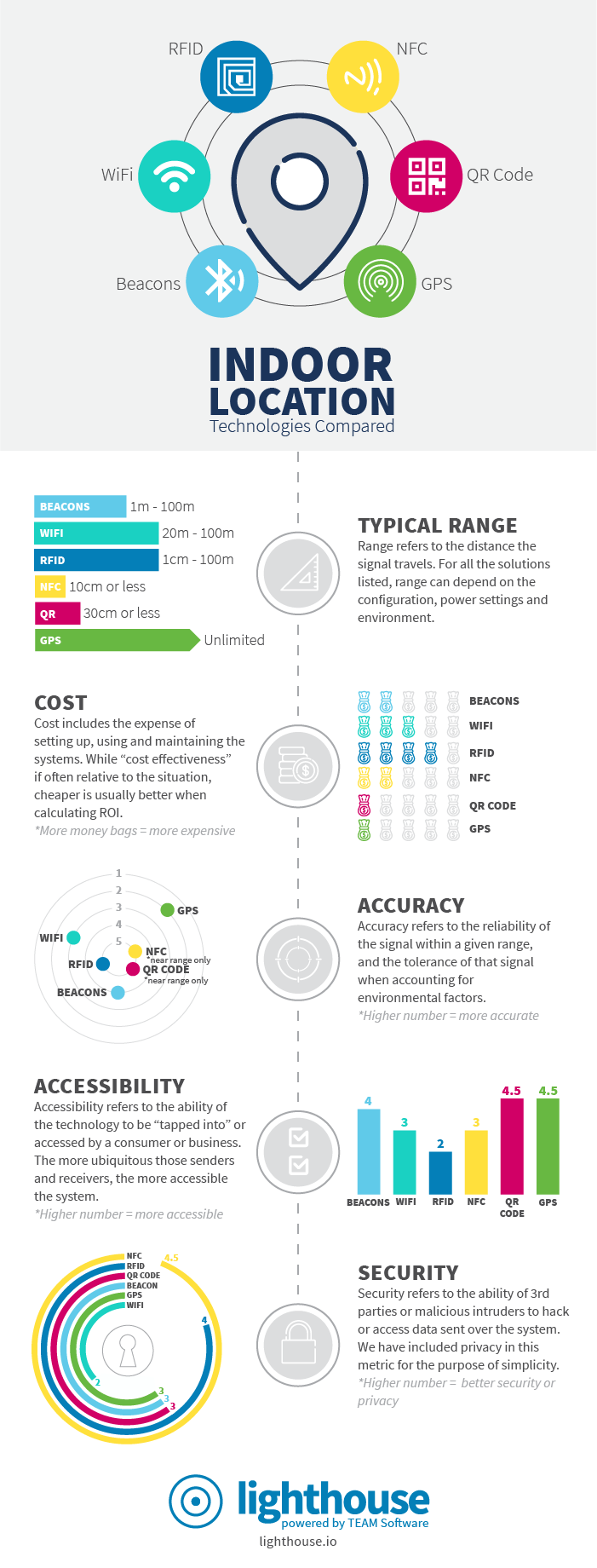Six Technologies Used to Track Location
A comparative look at the top options to track your distributed workforce.
When you’re a janitorial or security contractor in charge of managing a distributed workforce, there are several ways to track your people and assets. And as technology continues to march forward, you have more options than ever before.
When compared side by side, there’s not a clear “winner” in the indoor location tracking game, based on specs alone. Instead, the location solution you ultimately choose should be based on your specific application and requirements (i.e., tracking accuracy, budget/infrastructure, security, etc.). That’s why we’ve put together a comparison of six different indoor location technologies as they relate to tracking a distributed workforce.
GPS
These days, even the cheapest smartphones have decent GPS chips and most places on Earth have GPS coverage. Thanks to a newer satellite broadcast and mass-market chips that can pinpoint accuracy to within one foot, smartphone GPS is getting even more accurate. This accuracy makes a big difference in cities and high-density locations where the reflection off and within buildings has previously limited GPS practicality for indoor tracking purposes.
GPS is already the solution we recommend most for outdoor tracking, vehicle patrol or “roaming” use cases where simple attendance is the main requirement for tracking. As GPS accuracy improves and device batteries become more powerful, GPS could increasingly become the cheapest, most ubiquitous option for all kinds of passive people tracking.

QR Codes
Unlike other location solutions, QR codes don’t have passive or in the background tracking capability. They’re more like near-field communication (NFC) in that they require a close proximity scan and, unlike NFC, actually require the user to open up an app or scanner to make that scan.
However, QR codes are very inexpensive to implement — they can be produced automatically and sold for the price of a sticker. And, importantly, QR scanners are as ubiquitous as mobile devices. For cases where hundreds of tracking points may be required, such as building security or janitorial in large commercial office buildings, the ROI on QR codes might make the most sense.
RFID
A radio-frequency identification or RFID system is comprised of tags, readers that communicate with each other using radio waves, and reader control and application software. Passive RFID systems are characterised by tags that are powered by the readers, meaning they don’t require a power source. Active RFID systems have more expensive, battery-powered tags that broadcast their own signal at a range up to 100 yards.
RFID is a hugely popular system in distribution, logistics and inventory management for its ability to identify many items at once without direct line-of-sight. Typically, installing an RFID system requires a lot of work and varies widely in cost and function based on the different types of tags and readers. But because of the maturity and range of options available with RFID, it’s possible to make almost any use case work.
NFC
The popularity of NFC and its use in consumer applications is on the rise. NFC systems are a type of RFID, conveniently built into most Android and Apple devices and great for payment and ticketing applications. It’s inexpensive to implement NFC tags and they work with any contactless terminal.
As a form of passive RFID, it’s highly energy efficient — creating its own power when in the presence of an NFC-enabled smart device — and highly accurate. And, it can be used on one-way communication or two-way communication. However, per its name, NFC is a “near-field” communication system meaning it only works within a four-inch range of a terminal.
WiFi
WiFi hotspots are effectively “fixed” anchor points providing a static known position. A device detects a WiFi access point and, once multiple points are detected, can determine its position. If location details are only needed at the room or zone level, WiFi can be a great, low-cost solution over GPS.
One of the biggest advantages of using WiFi technology is that it’s usually a pre-existing infrastructure in many locations and works well with mobile devices. WiFi also has a much higher bandwidth for cases when internet access and data transfer are required.
BLE Beacons
The increased broadcast message capacity of Bluetooth improves the effectiveness of beacons for safety and emergency management tracking applications. In instances where data connectivity is a challenge like in underground or labyrinthian buildings, the mesh network capability provided by the Bluetooth standard presents the ability to send tracking data and distress alerts directly over Bluetooth.
As Bluetooth-enabled devices become more ubiquitous in smart buildings (i.e. beacons, lighting fixtures, WiFi access points), the cost of deploying a beacon infrastructure for indoor tracking goes down.
As our reliance on devices increases and location technologies continue to improve, the mobile applications that use these technologies grow. While these six technologies are only a handful of tracking advancements, we’ve highlighted the ones that have seen some of the most interesting changes in recent years.
